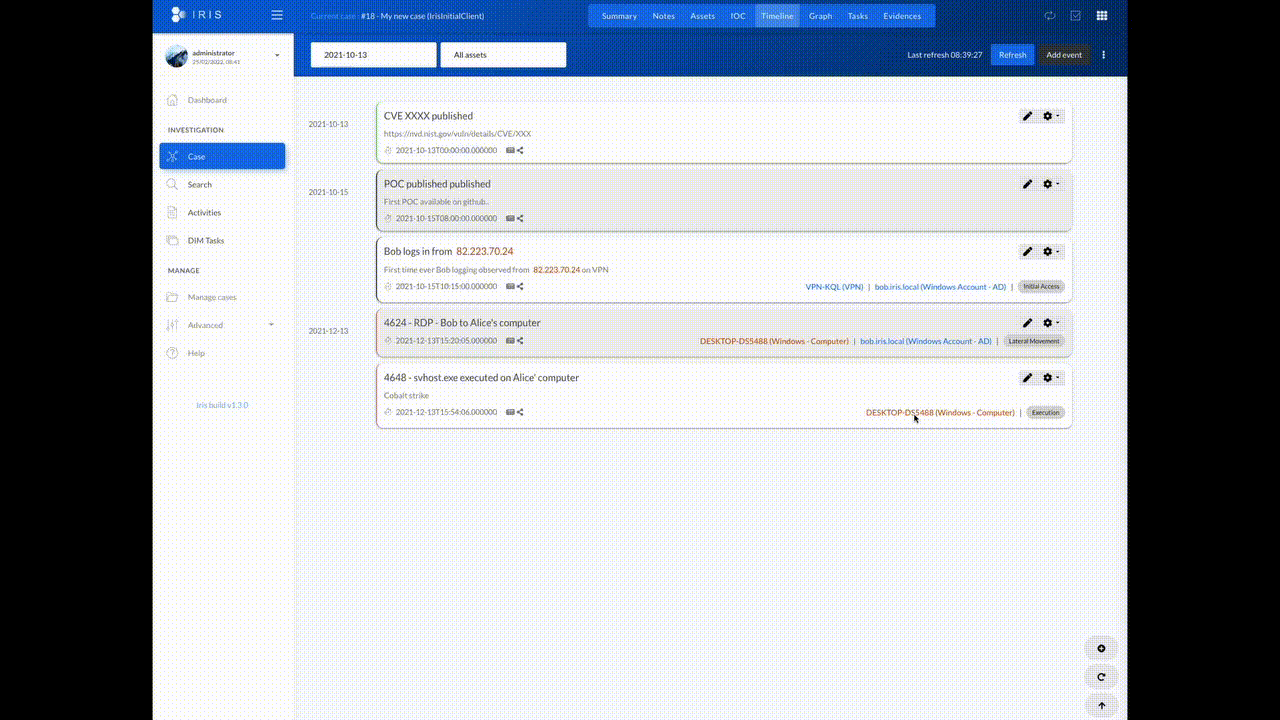Incident Response Investigation System
IRIS is a web collaborative platform for incident response analysts allowing to share investigations at a technical level.
It is divided in two main parts, IrisWeb and IrisModules.
- IrisWeb is the web application which contains the core of Iris (web interface, database management, etc).
- IrisModules are extensions of the core that allow third parties to process data via Iris (eg enrich IOCs with MISP and VT, upload and injection of EVTX into Splunk).
IrisWeb can work without any modules though defaults ones are preinstalled. Head to Manage > Modules in the UI
to configure and enable them.
Iris is split on 5 Docker services, each with a different role.
app - iris_webapp: The core, including web server, DB management, module management etc.db: A PostgresSQL databaseRabbitMQ: A RabbitMQ engine to handle jobs queuing and processingworker: Jobs handler relying on RabbitMQnginx: A NGINX reverse proxy
Each service can be built independently, which can be useful when developing.
# Clone the iris-web repository
git clone https://github.com/dfir-iris/iris-web.git
cd iris-web
# Copy the environment file
cp .env.model .env
# [... optionally, do some configuration as specified below ...]
# Build the dockers
docker-compose build
# Run IRIS
docker-compose upIris will be available on the host interface, port 4433, protocol HTTPS - https://<your_instance_ip>:4433.
By default, an administrator account is created. The password is printed in stdout the very first time Iris is started. It won't be printed anymore after that.
You can search for WARNING :: post_init :: create_safe_admin :: >>> in the logs to find the password.
If you want to define an admin password at the first start, you can also create and define the environment variable IRIS_ADM_PASSWORD in the app docker instance (see the webApp Dockerfile). This has no effects once the administrator account is created.
You can skip this part if you just want to try or develop. If used in production, please configure the .env file at the root of the project:
- Nginx: you might want to specify your own certificate as specified above
- Database credentials: POSTGRES_PASSWORD and DB_PASS (you can also customise the usernames)
- IRIS secrets: SECRET_KEY and SECURITY_PASSWORD_SALT
For a more comprehensive overview of the case features, you can head to tutorials, we've put some videos there.
Please read the release notes when upgrading versions. Most of the time the migrations are handled automatically, but some changes might require manual labor depending on the version.
A comprehensive documentation is available on dfir-iris.github.io.
The API reference is available in the documentation or documentation repository.
You can reach us on Discord or by mail if you have any question, issue or idea !
Iris is in its early stage. It can already be used in production, but please set backups of the database and DO NOT expose the interface on the Internet. We highly recommend using a private dedicated and secured network.
The contents of this repository is available under LGPL3 license.


